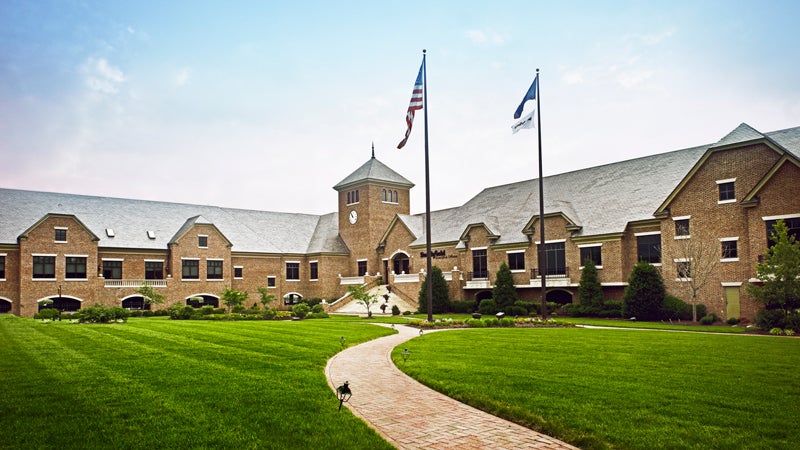‘Cottages’ development draws mixed reaction from Planning Commission
Published 3:01 pm Thursday, September 12, 2024

- Site plan shows 130 single-family homes behind the Royal Farms gas station at the corner of Battery Park Road and South Church Street (Image courtesy of AES Consulting)
At least three members of Smithfield’s Planning Commission say a 130-home development slated for 14 acres behind the Royal Farms convenience store at Battery Park Road and South Church Street – dubbed “The Cottages at Battery” – is an improvement over the 150-unit condominium complex approved for the same site in 2020.
Commissioner Charles Bryan and area residents who spoke at the meeting, however, say what’s proposed is still too dense and less affordable than what was originally proposed.
Commissioners and attendees at the body’s Sept. 10 meeting each voiced their initial reactions to Suffolk-based Quality Homes Inc.’s plans for the land ahead of a required public hearing, which has yet to be scheduled. Once the formal hearing is held, the Planning Commission will vote on developer Brian Mullins’ request for seven special use permits and a Planning Commission waiver.
Mullins, who did not attend the meeting, acquired the 14 acres in April from Virginia Beach-based developer John Mamoudis, who in 2020 received Town Council approval for multifamily residential zoning to construct 15 two-story multifamily buildings, each containing 10 units.
Quality Homes’ concept calls for 130 detached roughly 1,000- to 1,300-square-foot one- and two-story houses under condominium-style ownership, where residents would own the homes’ interiors but the surrounding land and exterior of each house would be owned and maintained by a homeowners association.
“It’s a much better look,” said Planning Commission Chairwoman Julia Hillegass.
Community Development and Planning Director Tammie Clary told the commissioners that the request is technically for a zoning amendment, not a full rezoning.
The zoning would remain multifamily residential, she said.
A month prior to the land changing hands, the Town Council approved Mullins’ requested rewording of the town’s zoning ordinance that would allow him to request special use permits for elements of his proposal that don’t conform to its attached residential zoning requirements, but Quality Homes isn’t seeking attached residential zoning.
The existing multifamily zoning allows up to 12 units per acre, but it stipulates that any attached housing comply with the lower 8-unit-per-acre density required in the town’s attached residential zoning ordinance.
“You almost have a double layer of two different zoning districts that are kind of being applied as one,” Clary said.
The conceptual plan for The Cottages shows some of the houses with rear-to-rear attached garages, which is why the attached residential requirements apply. One of the special use permits Quality Homes is seeking would allow a density of 10 units per acre for the homes with garages.
“The density is the biggest issue with this development; 10 units per acre is not acceptable,” said downtown resident and Town Council candidate Mary Ellen Bebermeyer, who was one of six speakers during the meeting’s public comment period who spoke in opposition to Quality Homes’ proposal.
Commissioner Thomas Pope, however, urged his fellow commissioners to focus on the aesthetics of the single-family home proposal versus the stalled two-story condominium complex rather than density, contending concerns over the town’s capacity to absorb the influx of traffic and new residents had already been addressed in 2020 when the 150-home development was approved.
“Yes, they’re closer together, yes they’re dense, but it’s not as dense as what was there,” Pope said.
Nathan Diehl, representing Quality Homes instead of Mullins, said the single-family homes would carry a base price of $300,000 to $350,000, up from the $190,000 minimum price Mamoudis had proposed in 2020 when he’d proposed the units as affordable starter homes.
An average price of $400,000 per unit “is very viable,” Diehl said.
Commissioner Randy Pack asserted, and Diehl confirmed, that any further reduction in density beyond the 130 units proposed could further drive up the cost per unit, making them even less affordable.
“When we look at affordable housing, which is one of the things that we desire, that is a consideration,” Pack said.
The other six requested special use permits would eliminate the otherwise-required recreational vehicle parking, allow homes to be built 17 feet apart instead of the ordinance’s minimum 24, allow fewer than the minimum three attached units required under the definition of attached residential, allow “zero lot line” development to facilitate communal ownership of the land surrounding each house, and allow 34-foot corner lots down from 35. The requested Planning Commission waiver would allow for non-contiguous open space.
Commissioner GiGi Smith said she also preferred the single-family concept to the multifamily buildings.
Commissioner Charles Bryan, who cast the dissenting vote in a 4-1 January decision by the Planning Commission to recommend approval of Quality Homes’ requested changes to the town’s definition of attached residential zoning, disagreed with Pope that density is a non-issue.
Bryan noted that the development is modeled off another Quality Homes development in Suffolk, dubbed “The Landings,” which operates under a similar condominium-style ownership to what’s proposed at The Cottages.
“The question is do we want to effectively import Suffolk, Portsmouth, Virginia Beach-type ordinances, growth, density and infrastructure costs,” Bryan said.
“We have no answer for affordable homes,” Bryan added. “This project provides proof of that. The houses of this application are much smaller than average, yet the prices are about the same – estimated around $400,000 per unit – without the ownership of the land around it.”





